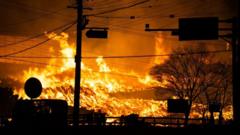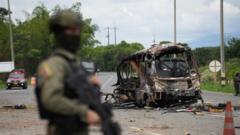The unprecedented wildfire crisis has led to a significant loss of life and cultural heritage, while authorities scramble to contain the rampant flames.
**Tragic Wildfires in South Korea Claim 24 Lives, Devastate Communities**

**Tragic Wildfires in South Korea Claim 24 Lives, Devastate Communities**
Multiple wildfires ravage South Korea, leaving destruction in their wake, with historical sites and thousands of residents affected.
At least 24 people have tragically lost their lives as a result of multiple wildfires sweeping through Southeast South Korea, marking one of the nation's darkest environmental crises. Many of the deceased are elderly residents in their 60s and 70s, according to officials, while an additional 26 individuals are reported injured—12 of whom are in critical condition. The ongoing fires have forced over 23,000 people to evacuate their homes in search of safety.
This “unprecedented” wildfire situation has been defined as the worst in South Korea's history by acting President Han Duck-soo, who remarked on the catastrophic scale of destruction. The raging fires destroyed a historic Buddhist temple in Uiseong city, where many priceless cultural artifacts were hastily removed to avoid devastation. The wildfires are believed to have originated in Sancheong county on a Friday and quickly spread due to strong, dry winds to Uiseong and its neighboring areas of Gyeongbuk, Andong, Cheongsong, Yeongyang, and Sancheong.
As the fire situation escalated, the national fire agency raised its emergency response to the highest level. On Wednesday, tragedy struck again when a firefighting helicopter crashed in the mountains around Uiseong, resulting in the death of the pilot; investigations into the incident are currently ongoing. To combat the flames, thousands of firefighters and approximately 5,000 military personnel have been mobilized, along with helicopters from the U.S. military stationed in Korea.
The scale of the crisis is highlighted by the destruction of about 17,000 hectares (approximately 42,000 acres) of forest, with current conditions rendering it the deadliest and third-largest wildfire incident in South Korean history by area. As many residents share harrowing accounts, one villager from Andong described their destroyed home, saying, “It was almost completely collapsed.” Another resident in Uiseong echoed sentiments of despair as widespread destruction swept through neighborhoods historically occupied by the elderly.
A 68-year-old monk expressed profound devastation regarding the destruction of the renowned Gounsa temple, constructed in 618 AD. He pledged commitment to restoring the temple's purposes essential to the community. Witnesses, including a truck driver named Lee Seung-joo, recounted visuals of an overwhelming inferno: “It was like the apocalypse,” he said.
Despite the efforts of emergency responders, the acting president highlighted that persistent strong winds continue to obstruct firefighting operations. “We were desperately hoping for rain today or tomorrow,” Han said, conveying concern as weather forecasts indicated no immediate precipitation in sight. Compounding the situation, South Korea has been ritually experiencing drier-than-average conditions, contributing to an alarming increase in wildfires this year—244 incidents, which is 2.4 times more than recorded in the same period last year.
In response to this calamity, the government has pledged to strengthen regulations against illegal burning, which has been identified as a leading cause of such wildfires, as well as to address individual negligence that exacerbates the severity of fire outbreaks.
This “unprecedented” wildfire situation has been defined as the worst in South Korea's history by acting President Han Duck-soo, who remarked on the catastrophic scale of destruction. The raging fires destroyed a historic Buddhist temple in Uiseong city, where many priceless cultural artifacts were hastily removed to avoid devastation. The wildfires are believed to have originated in Sancheong county on a Friday and quickly spread due to strong, dry winds to Uiseong and its neighboring areas of Gyeongbuk, Andong, Cheongsong, Yeongyang, and Sancheong.
As the fire situation escalated, the national fire agency raised its emergency response to the highest level. On Wednesday, tragedy struck again when a firefighting helicopter crashed in the mountains around Uiseong, resulting in the death of the pilot; investigations into the incident are currently ongoing. To combat the flames, thousands of firefighters and approximately 5,000 military personnel have been mobilized, along with helicopters from the U.S. military stationed in Korea.
The scale of the crisis is highlighted by the destruction of about 17,000 hectares (approximately 42,000 acres) of forest, with current conditions rendering it the deadliest and third-largest wildfire incident in South Korean history by area. As many residents share harrowing accounts, one villager from Andong described their destroyed home, saying, “It was almost completely collapsed.” Another resident in Uiseong echoed sentiments of despair as widespread destruction swept through neighborhoods historically occupied by the elderly.
A 68-year-old monk expressed profound devastation regarding the destruction of the renowned Gounsa temple, constructed in 618 AD. He pledged commitment to restoring the temple's purposes essential to the community. Witnesses, including a truck driver named Lee Seung-joo, recounted visuals of an overwhelming inferno: “It was like the apocalypse,” he said.
Despite the efforts of emergency responders, the acting president highlighted that persistent strong winds continue to obstruct firefighting operations. “We were desperately hoping for rain today or tomorrow,” Han said, conveying concern as weather forecasts indicated no immediate precipitation in sight. Compounding the situation, South Korea has been ritually experiencing drier-than-average conditions, contributing to an alarming increase in wildfires this year—244 incidents, which is 2.4 times more than recorded in the same period last year.
In response to this calamity, the government has pledged to strengthen regulations against illegal burning, which has been identified as a leading cause of such wildfires, as well as to address individual negligence that exacerbates the severity of fire outbreaks.























